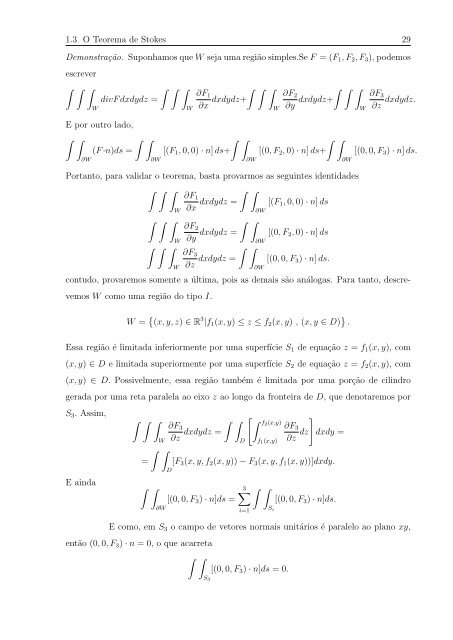O Teorema de Stokes em Variedades - Fernando UFMS/CPAq
O Teorema de Stokes em Variedades - Fernando UFMS/CPAq
O Teorema de Stokes em Variedades - Fernando UFMS/CPAq
You also want an ePaper? Increase the reach of your titles
YUMPU automatically turns print PDFs into web optimized ePapers that Google loves.
1.3 O <strong>Teor<strong>em</strong>a</strong> <strong>de</strong> <strong>Stokes</strong> 29<br />
D<strong>em</strong>onstração. Suponhamos que W seja uma região simples.Se F = (F1, F2, F3), po<strong>de</strong>mos<br />
escrever<br />
<br />
W<br />
<br />
divF dxdydz =<br />
E por outro lado,<br />
<br />
∂W<br />
<br />
(F ·n)ds =<br />
∂W<br />
W<br />
∂F1<br />
∂x dxdydz+<br />
<br />
W<br />
∂F2<br />
∂y dxdydz+<br />
<br />
W<br />
∂F3<br />
∂z dxdydz.<br />
<br />
<br />
[(F1, 0, 0) · n] ds+ [(0, F2, 0) · n] ds+ [(0, 0, F3) · n] ds.<br />
∂W<br />
∂W<br />
Portanto, para validar o teor<strong>em</strong>a, basta provarmos as seguintes i<strong>de</strong>ntida<strong>de</strong>s<br />
<br />
<br />
<br />
W<br />
W<br />
W<br />
<br />
∂F1<br />
dxdydz = [(F1, 0, 0) · n] ds<br />
∂x ∂W<br />
∂F2<br />
dxdydz =<br />
∂y<br />
∂F3<br />
dxdydz =<br />
∂z<br />
<br />
<br />
∂W<br />
∂W<br />
[(0, F2, 0) · n] ds<br />
[(0, 0, F3) · n] ds.<br />
contudo, provar<strong>em</strong>os somente a última, pois as <strong>de</strong>mais são análogas. Para tanto, <strong>de</strong>scre-<br />
v<strong>em</strong>os W como uma região do tipo I.<br />
W = (x, y, z) ∈ R 3 |f1(x, y) ≤ z ≤ f2(x, y) , (x, y ∈ D) .<br />
Essa região é limitada inferiormente por uma superfície S1 <strong>de</strong> equação z = f1(x, y), com<br />
(x, y) ∈ D e limitada superiormente por uma superfície S2 <strong>de</strong> equação z = f2(x, y), com<br />
(x, y) ∈ D. Possivelmente, essa região também é limitada por uma porção <strong>de</strong> cilindro<br />
gerada por uma reta paralela ao eixo z ao longo da fronteira <strong>de</strong> D, que <strong>de</strong>notar<strong>em</strong>os por<br />
S3. Assim,<br />
E ainda<br />
<br />
W<br />
<br />
=<br />
<br />
∂W<br />
f2(x,y)<br />
∂F3<br />
∂F3<br />
dxdydz =<br />
∂z D f1(x,y) ∂z dz<br />
<br />
dxdy =<br />
D<br />
[F3(x, y, f2(x, y)) − F3(x, y, f1(x, y))]dxdy.<br />
[(0, 0, F3) · n]ds =<br />
3<br />
<br />
i=1<br />
Si<br />
[(0, 0, F3) · n]ds.<br />
E como, <strong>em</strong> S3 o campo <strong>de</strong> vetores normais unitários é paralelo ao plano xy,<br />
então (0, 0, F3) · n = 0, o que acarreta<br />
<br />
S3<br />
[(0, 0, F3) · n]ds = 0.



